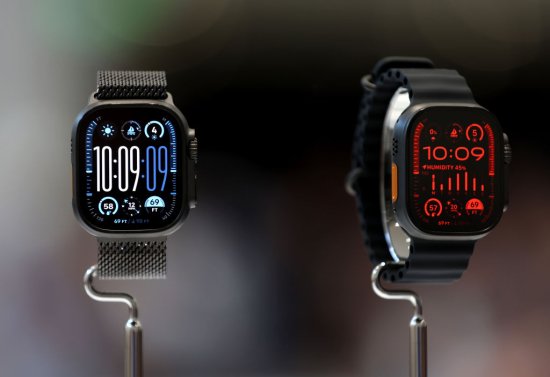
Need a hearing aid? Try AirPods. And the new Apple Watch can detect sleep apnea.
This week, Apple announced that its devices will have two new health-related capabilities: your Apple Watch will soon be able to tell if you have sleep apnea, and your AirPods Pro 2 can now double as hearing aids for those who need them.
Jeff Williams, chief operating officer at Apple, told TIME in his first interview about the new health features that while Apple began providing health-related capabilities initially focused on fitness, the company will “continue to pull on the threads” in the health space. Already, Apple devices can detect or track heart and respiratory rates, menstrual cycles, body temperature, perform electrocardiograms to record heart rhythms, monitor sleep cycles and detect falls, not to mention serve as a fitness apps for workouts and activity. And those features will likely only continue to grow. “So many people have our devices with them that we view this as an opportunity, and maybe even a moral responsibility, to do more in this space,” he says. “We don’t know where the journey is going in terms of where we’ll end; we’re at the very beginning.”
[time-brightcove not-tgx=”true”]Here’s what to know.
How the Apple Watch can detect sleep apnea
Apple Watch already detects irregular heart rhythms, and the Apple Health app can track things like steps, activity, and time spent asleep. The latest Apple Watch—Series 10, which goes on sale Sept. 20—also contains an ultra-sensitive accelerometer that can detect tiny changes in breathing patterns via the wrist while someone is sleeping. Over a 30-day period, it analyzes the patterns and informs the wearer if they might have enough sleep disturbances to suggest sleep apnea—even the mild kind.
According to Apple scientists, the accelerometer is sensitive enough to pick up the smallest physical manifestations of breathing, even if the person doesn’t seem to be moving, as breathing movements from the chest are conveyed to the extremities, including the wrist.
Read More: 15 Things to Say When Someone Comments on Your Weight
A past version of the Apple Watch used another way to detect sleep apnea that doctors include when they diagnose sleep apnea: a pulse oximeter, which uses specific wavelengths of light to track differences in oxygen levels in red blood cells. But in Oct. 2023, the U.S. International Trade Commission determined that Apple infringed on patents for the pulse oximetry technology it used that were held by another company, Masimo, and banned the company’s watch imports into the U.S. Apple stopped including the feature in watches sold in the U.S. starting Jan. 2024 while the company appeals the ban.
Williams said that the decision to rely on the accelerometer for detecting sleep apnea “really had nothing to do with the current legal situation, and was based on science and on studies. We found that the accelerometer data was really beneficial [for detecting sleep disturbances that could indicate sleep apnea]. It was less so for blood oxygen.”
The feature isn’t designed to diagnose sleep apnea, but can give users an early warning that they might have the condition. Data are stored on Apple’s Health app—encrypted and protected so only the user has access to it and Apple does not, according to Williams—so doctors can analyze it and make an actual clinical diagnosis using other information the doctors collect. On Sept. 16, the U.S. Food and Drug Administration (FDA) cleared the feature as a software update on Apple Watch Series 10, Series, 9 and Ultra 2 models.
AirPods Pro: your new hearing aids
While Apple is introducing updated versions of its entry-level AirPods (called AirPods 4), its AirPods Pro 2, which the company released last year, will remain the same. But with a new, free software update, users will be able to conduct professional-grade hearing tests and turn their AirPods Pro 2 into hearing aids and to make adjustments to refine their hearing, without needing a doctor, to address mild-to-moderate hearing loss. On Sept. 12—three days after Apple announced the pending availability of the hearing aid feature in the devices—the FDA approved the software as hearing aids, making the AirPods Pro 2 the first such hearing aid software device.
Read More: Green Tea Is Even Better For You Than You Think
AirPods already contain a feature that can alert wearers when sounds are too loud for hearing safety, and then reduce those levels. The software update, called Hearing Aid Feature, will provide a clinical-grade hearing test similar to the one professionals use to diagnose hearing loss. “In reality, there is no difference in the results from the hearing test from the AirPods than with a clinical audiogram,” Dr. Sumbul Desai, vice president of health at Apple, tells TIME.
Here’s how the test works: users tap on their iPhone screen to indicate which tones, played at different frequencies through the AirPods Pro 2, they can hear. The app provides a report indicating whether the person has mild, moderate, or severe hearing loss; the data can also be interpreted by a hearing expert to determine what type of hearing loss someone may have.
Based on the results, people with mild-to-moderate hearing loss can then follow instructions in the Apple Health app to adjust their AirPods Pro 2 into hearing aids, which Desai says are “equivalent to other devices out there” for similar levels of hearing loss. The advantage in having the AirPods Pro 2 serve the dual roles of listening devices and hearing aids, says Williams, include “convenience and simplicity,” as people can conduct the hearing test and improve their hearing with a single device. About 85% of hearing loss falls into the mild-to-moderate range.
The hearing aid feature will be available as a software update for the new AirPods Pro 2 this fall.
Update, Sept. 16
This story has been updated to reflect FDA clearance of the sleep apnea feature.